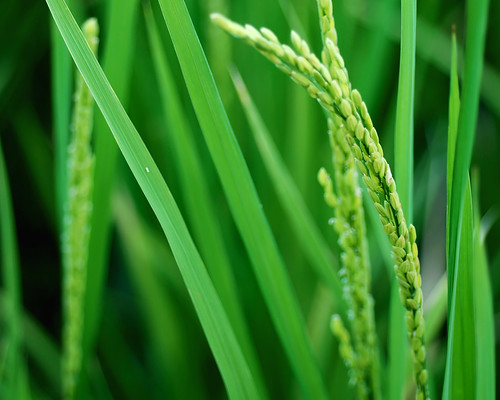Golden Grains
 Last night, I was able to catch the second half of a TV docu “Butil ng Buhay” (in English: Grain of Life) on GMA 7’s Reporter’s Notebook. And just like any other documentaries, this one had me thinking about the irony of Filipino life.
Last night, I was able to catch the second half of a TV docu “Butil ng Buhay” (in English: Grain of Life) on GMA 7’s Reporter’s Notebook. And just like any other documentaries, this one had me thinking about the irony of Filipino life.The docu zeroed in on the causes of the seemingly unforeseen rice crisis in my country. According to the experts, the
Backtracking to the 70’s when we held the distinction of being a prime source of this life-giving grain, the rice (oryza sativa). It is our main staple, complementing every viand on the table – whether it’s sardines straight from the can or the most delicious ulam. Fast forward to the present, what will happen to the marginalized sector of our society – those who only have rice as their basic source of sustenance each day – if it will be taken away from them due to their inability to cough up the extra pesos needed to buy a kilo?
More expert opinion pointed out the fact that the PI government has forgotten about agriculture. Whatever plans or measures taken never really addressed the needs for better irrigation, sturdier seeds, farm-to-market roads, technology and training. Like everything has fallen off the carabao-driven sled. Those who should have been the focus of this countrywide planning such as farmers, owners and agriculturists were never given that much priority. It’s been said that the government would rather spend a big sum in rice importation than spend more on upgrading agriculture methods. PGMA is quick to claim that there is no rice crisis here. Take another shot at reality: A former farmer has given up on planting rice again. He’s still planting alright, but not rice. He’s planting carabao grass instead. Easier to sell, low maintenance at hindi masyadong lugi (better ROI). Noted too was the truth that the PI doesn’t have a clearly defined land conversion fallback. A lot of farmlands are now converted into subdivisions, golf courses or malls. As one land owner said, the costs override the return. So what’s even the point of trying to hang on to a piece of land when the easiest way out is to sell it to the highest bidder?
A government agency which oversees rice production in the PI is the National Food Authority (NFA). There’s this thing about NFA rice. I’m not saying this to offend anyone. NFA rice is ok when newly-cooked, but when it’s cooled down (or as we say here, bahaw na or kanin-lamig), it’s not too ok anymore. Cooked and cold NFA rice can be tough on the gums. NFA said that there is no rice shortage yet. But this early, they are re-packing rice in 1-kilo bags. To avoid hoarding, countermeasures like: asking for proof of identity (IDs, birth certificate or residence certificate) is required from those who buy NFA rice in bulk. NFA also goes all over the PI to sell rice at Php 18.50 a kilo. Get this: The deficit in rice importation is way over NFA’s budget. Imported rice is about Php 30.00 a kilo minus NFA rice earnings equals to the government paying for the balance. End result: NFA’s almost 48 billion pesos in unpaid dues. What a way to go, taxpayers’ money.
Rice may be common in the PI but a lot of human effort goes to ensure that it maintains its nutritional appeal. It’s an amazing process – from choosing the binhi (seedlings), to planting, harvest, threshing, sun-drying, pa-molino (separating the rice chaffes from the grains), winnowing, cooking and serving. There’s a lot to be grateful for every grain of rice we have. The aroma of kanin na bagong ani (newly-harvested rice) is a gift, whether it’s a cup or half-a-cup.
Or in an empty cup? Hopefully not.
Labels: Life Issues


0 Comments:
Post a Comment
Subscribe to Post Comments [Atom]
<< Home